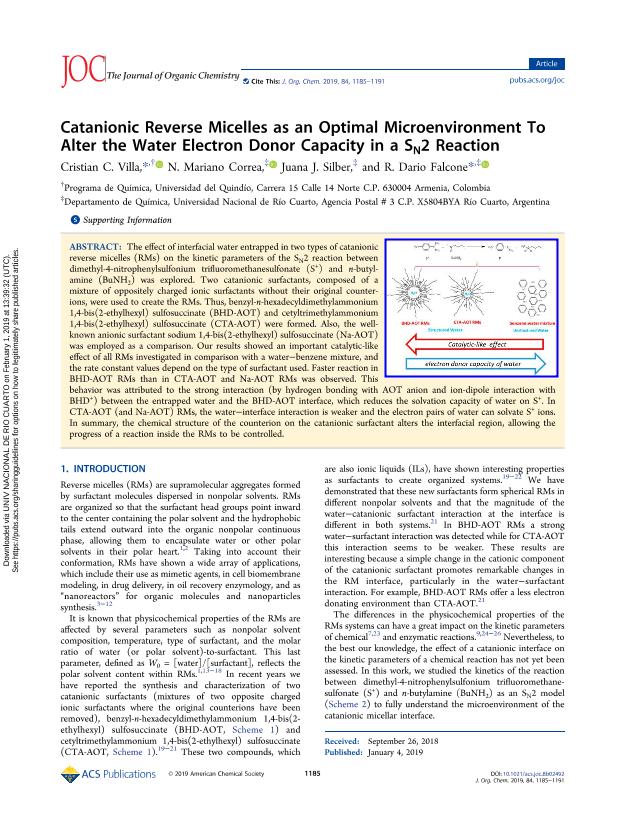Mostrar el registro sencillo del ítem
dc.contributor.author
Villa, Cristian C.
dc.contributor.author
Correa, Nestor Mariano

dc.contributor.author
Silber, Juana J.
dc.contributor.author
Falcone, Ruben Dario

dc.date.available
2020-12-18T14:02:14Z
dc.date.issued
2019-02
dc.identifier.citation
Villa, Cristian C.; Correa, Nestor Mariano; Silber, Juana J.; Falcone, Ruben Dario; Catanionic reverse micelles as an optimal microenvironment to alter the water electron donor capacity in a SN2 reaction; American Chemical Society; Journal of Organic Chemistry; 84; 3; 2-2019; 1185-1191
dc.identifier.issn
0022-3263
dc.identifier.uri
http://hdl.handle.net/11336/120837
dc.description.abstract
The effect of interfacial water entrapped in two types of catanionic reverse micelles (RMs) on the kinetic parameters of the SN2 reaction between dimethyl-4-nitrophenylsulfonium trifluoromethanesulfonate (S+) and n-butylamine (BuNH2) was explored. Two catanionic surfactants, composed of a mixture of oppositely charged ionic surfactants without their original counterions, were used to create the RMs. Thus, benzyl-n-hexadecyldimethylammonium 1,4-bis(2-ethylhexyl) sulfosuccinate (BHD-AOT) and cetyltrimethylammonium 1,4-bis(2-ethylhexyl) sulfosuccinate (CTA-AOT) were formed. Also, the well-known anionic surfactant sodium 1,4-bis(2-ethylhexyl) sulfosuccinate (Na-AOT) was employed as a comparison. Our results showed an important catalytic-like effect of all RMs investigated in comparison with a water-benzene mixture, and the rate constant values depend on the type of surfactant used. Faster reaction in BHD-AOT RMs than in CTA-AOT and Na-AOT RMs was observed. This behavior was attributed to the strong interaction (by hydrogen bonding with AOT anion and ion-dipole interaction with BHD+) between the entrapped water and the BHD-AOT interface, which reduces the solvation capacity of water on S+. In CTA-AOT (and Na-AOT) RMs, the water-interface interaction is weaker and the electron pairs of water can solvate S+ ions. In summary, the chemical structure of the counterion on the catanionic surfactant alters the interfacial region, allowing the progress of a reaction inside the RMs to be controlled. ©
dc.format
application/pdf
dc.language.iso
eng
dc.publisher
American Chemical Society

dc.rights
info:eu-repo/semantics/openAccess
dc.rights.uri
https://creativecommons.org/licenses/by-nc-sa/2.5/ar/
dc.subject
REVERSE MICELLES
dc.subject
CATANIONIC SURFACTANTS
dc.subject
IONIC LIQUID SURFACTANTS
dc.subject
CONFINED WATER
dc.subject.classification
Química Orgánica

dc.subject.classification
Ciencias Químicas

dc.subject.classification
CIENCIAS NATURALES Y EXACTAS

dc.title
Catanionic reverse micelles as an optimal microenvironment to alter the water electron donor capacity in a SN2 reaction
dc.type
info:eu-repo/semantics/article
dc.type
info:ar-repo/semantics/artículo
dc.type
info:eu-repo/semantics/publishedVersion
dc.date.updated
2020-11-05T18:32:44Z
dc.identifier.eissn
1520-6904
dc.journal.volume
84
dc.journal.number
3
dc.journal.pagination
1185-1191
dc.journal.pais
Estados Unidos

dc.description.fil
Fil: Villa, Cristian C.. Universidad del Quindio; Colombia
dc.description.fil
Fil: Correa, Nestor Mariano. Universidad Nacional de Río Cuarto. Instituto para el Desarrollo Agroindustrial y de la Salud. - Consejo Nacional de Investigaciones Científicas y Técnicas. Centro Científico Tecnológico Conicet - Córdoba. Instituto para el Desarrollo Agroindustrial y de la Salud; Argentina
dc.description.fil
Fil: Silber, Juana J.. Universidad Nacional de Río Cuarto. Facultad de Ciencias Exactas Fisicoquímicas y Naturales. Departamento de Química; Argentina
dc.description.fil
Fil: Falcone, Ruben Dario. Universidad Nacional de Río Cuarto. Instituto para el Desarrollo Agroindustrial y de la Salud. - Consejo Nacional de Investigaciones Científicas y Técnicas. Centro Científico Tecnológico Conicet - Córdoba. Instituto para el Desarrollo Agroindustrial y de la Salud; Argentina. Universidad Nacional de Río Cuarto. Facultad de Ciencias Exactas Fisicoquímicas y Naturales. Departamento de Química; Argentina
dc.journal.title
Journal of Organic Chemistry

dc.relation.alternativeid
info:eu-repo/semantics/altIdentifier/doi/https://doi.org/10.1021/acs.joc.8b02492
dc.relation.alternativeid
info:eu-repo/semantics/altIdentifier/url/https://pubs.acs.org/doi/10.1021/acs.joc.8b02492
Archivos asociados
